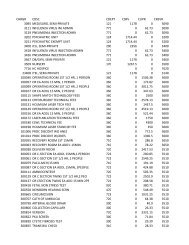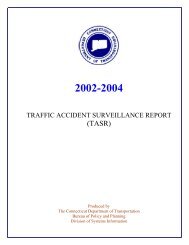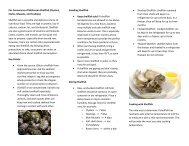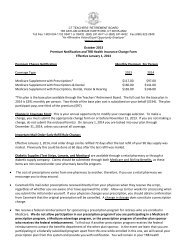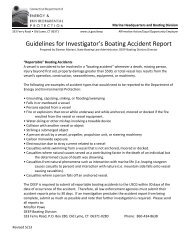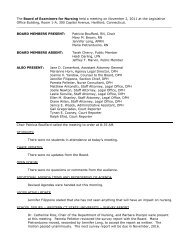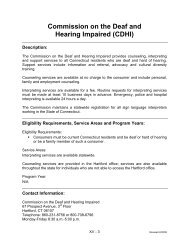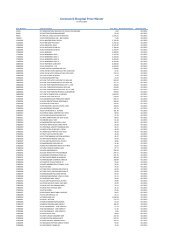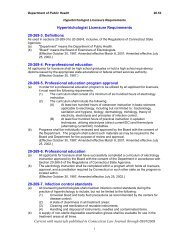Public Act 490 Guide - CT.gov
Public Act 490 Guide - CT.gov
Public Act 490 Guide - CT.gov
Create successful ePaper yourself
Turn your PDF publications into a flip-book with our unique Google optimized e-Paper software.
FARMLAND CLASSIFICATION<br />
SE<strong>CT</strong>ION 5: FARMLAND CLASSIFICATION<br />
ABOUT CONNE<strong>CT</strong>ICUT AGRICULTURE<br />
Connecticut agriculture continues to evolve as it has<br />
since the land use assessment program embodied in PA <strong>490</strong><br />
was enacted in 1963. Family farms, considered the cornerstone<br />
of “traditional agriculture”, have evolved into smaller<br />
and more diversified farms. Some farms, mainly dairy, have<br />
become larger and typically use a great deal of rented and<br />
leased land, while others have become smaller and more<br />
specialized. Today, farms in Connecticut are diverse and<br />
include: organic operations, orchards, vegetables, tobacco,<br />
vineyards, Christmas trees, nurseries, greenhouses, maple<br />
syrup, horses, shellfish, goat and cow cheeses, fruit and<br />
berry juices, wine, wool, grass-fed beef, manure flower pots,<br />
micro-greens, poultry, eggs and honey among others.<br />
According to the 2007 Census of Agriculture, Connecticut<br />
has 405,616 acres of land in farms (including cropland,<br />
woodland, and shellfish grounds) and 1,227,000 acres of<br />
commercially-viable forest land. The average farm size is<br />
83 acres, the third smallest in the U.S. More than half of<br />
Connecticut’s 4,916 farms are less than 50 acres. The average<br />
age of a farm operator is 55 years. However this ratio is<br />
beginning to change, and many new farmers are entering<br />
the marketplace to help meet this demand for locally<br />
grown products. This has meant a change in the diversity<br />
of farms, what they produce, and an increase in direct<br />
marketing retail sales. Farms in the state ranked first in<br />
New England in terms of market value at $1,360 per acre.<br />
Using remote sensing technology to detect land<br />
use changes between 1985 and 2006, recent research<br />
by the University of Connecticut has identified<br />
changes in the state's agricultural land use. By 2006,<br />
the state had lost 39,522 acres of the agricultural<br />
fields present in 1985—a 14.5% decrease.<br />
— University of Connecticut, Center for Land Use Education and<br />
Research, Agricultural Fields and Soils in Connecticut, 2010<br />
1 Connecticut’s Changing Landscape, Version 2, University of Connecticut,<br />
Center for Land Use Education and Research, 2006.<br />
Connecticut farms provided an estimated $511 million in<br />
cash receipts in 2007 and also provided $442 million<br />
annually in environmental benefits such as maintaining<br />
habitats and buffers, filtering water, and reducing flooding.<br />
What does this all mean in the context of PA <strong>490</strong>? It<br />
means that preserving farmland, woodland, and open space<br />
is of utmost importance in this century. Agricultural soils are<br />
the backbone of the agricultural sector. The re-emergence<br />
of the local food movement means that there is a need to<br />
maintain a land base in order to meet the consumer<br />
demand for locally grown farm and forest products.<br />
Unfortunately, the loss of farmland to non-agricultural use<br />
is a constant threat. Between 1985-2006 Connecticut lost<br />
on average 1883 acres annually. 1 If the land base continues<br />
to transfer to other uses at the present rate, Connecticut<br />
farmers and forest owners will not be able to meet the evergrowing<br />
demand for locally grown agricultural products.<br />
Connecticut Cash Receipts – 2008<br />
By Commodity in Thousands of Dollars<br />
Milk<br />
$72,720<br />
Other Crops<br />
$75,451<br />
Other Livestock<br />
and Poultry<br />
$27,417<br />
Aquaculture<br />
$27,600<br />
Fruits and Vegetables<br />
$63,449<br />
Eggs<br />
$60,116<br />
Greenhouse and Nursery<br />
$273,840<br />
Connecticut Total = $600.6 Million<br />
Other Livestock and Poultry does not include milk, eggs and aquaculture.<br />
Fruits and Vegetables = sweet corn and other vegetables; apples, peaches,<br />
berries, and other fruit.<br />
Other Crops = hay, tobacco, maple syrup, and all other crops.<br />
Source: United States Department of Agriculture<br />
8<br />
<strong>Public</strong> <strong>Act</strong> <strong>490</strong>: A Practical <strong>Guide</strong> and Overview • http://www.cfba.org/pa<strong>490</strong>guide.htm • Connecticut Farm Bureau Association




